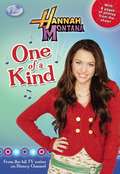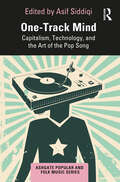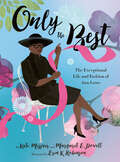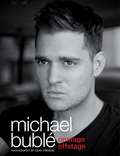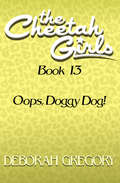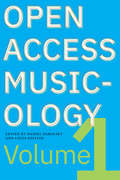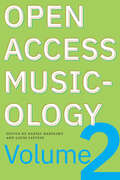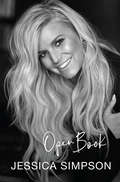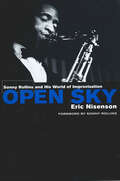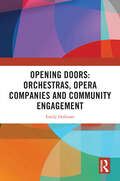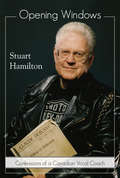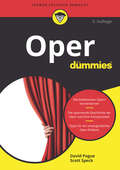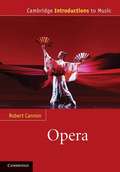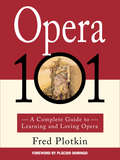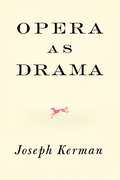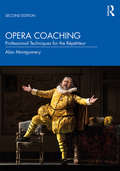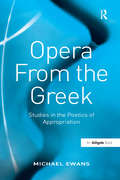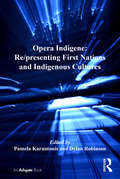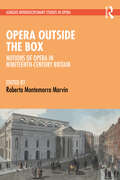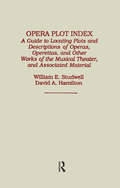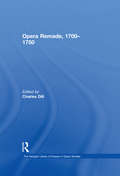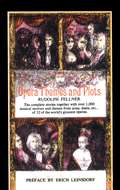- Table View
- List View
One of a Kind
by Chris GormanBold, graphic art by indie rocker Chris Gorman of Belly captures the thrill and challenges of marching to your own beat.Meet a pogo-dancing, punk-rock-loving kid who loves to express himself in his own unique way. His clothes, hairstyle, music, and just the way he hears the world, all set him apart. Not everyone understands him, but he likes being one of a kind--even though it's lonely sometimes. Fortunately, it's a wide world out there, and if he looks around a kid is sure to find other one-of-a-kinds with common interests.
One of a Kind (Disney's Hannah Montana #17)
by Laurie McelroyAfter too many encores while performing as Hannah Montana at a recent concert, Miley Stewart loses her voice. Since Hannah is scheduled to sing on live TV in a week, Miley is under strict order to rest her vocal cords. This, of course, means trouble.
One-Track Mind: Capitalism, Technology, and the Art of the Pop Song (Ashgate Popular and Folk Music Series)
by Asif SiddiqiThe song remains the most basic unit of modern pop music. Shaped into being by historical forces—cultural, aesthetic, and technical—the song provides both performer and audience with a world marked off by a short, discrete, and temporally demarcated experience. One-Track Mind: Capitalism, Technology, and the Art of the Pop Song brings together 16 writers to weigh in on 16 iconic tracks from the history of modern popular music. Arranged chronologically in order of release of the tracks, and spanning nearly five decades, these essays zigzag across the cultural landscape to present one possible history of pop music. There are detours through psychedelic rock, Afro-pop, Latin pop, glam rock, heavy metal, punk, postpunk, adult contemporary rock, techno, hip-hop, and electro-pop here. More than just deep histories of individual songs, these essays all expand far beyond the track itself to offer exciting and often counterintuitive histories of transformative moments in popular culture. Collectively, they show the undiminished power of the individual pop song, both as distillations of important flashpoints and, in their afterlives, as ghostly echoes that persist undiminished but transform for succeeding generations. Capitalism and its principal good, capital, help us frame these stories, a fact that should surprise no one given the inextricable relationship between art and capitalism established in the twentieth century. At the root, readers will find here a history of pop with unexpected plot twists, colorful protagonists, and fitting denouements.
Only the Best: The Exceptional Life and Fashion of Ann Lowe
by Kate Messner Margaret E. PowellAn inspiring picture book biography of the amazing Anne Lowe, the first nationally-known African American fashion designer! A careful snip, a delicate fold.Fabric the color of new petals.Skirts that flare like upside-down blossoms.A garden bursts into bloom! There is no "good enough."For Ann, only the best will do. Award-winning author Kate Messner, costume historian Margaret E. Powell, and fashion designer and illustrator Erin Robinson tell the powerful story of the ground-breaking Ann Lowe, who grew up in a small Alabama dress shop and became the first nationally-known African American fashion designer. Sought after by millionaires and movie stars, her designs walked the red carpet and graced the wedding of Senator John F. Kennedy and Jacqueline Bouvier. At a time when the world around her thought African Americans deserved no more than second-class treatment, Ann expects no less of herself, and no less FOR herself, than the BEST. THE FIRST, FAMED BLACK FASHION DESIGNER: Although she faced many hardships, Anne's spirit, talent, and belief in herself always shone through. This story provides an empowering, real-life role model for young girls—and especially Black girls—to relate to and see themselves in, at an age when building self-confidence is more important than ever! ENCOURAGES CREATIVITY AND PERSERVERENCE: Full of interesting details about how Anne came up with her designs, and how she always forged ahead in spite of setbacks, this true story will captivate aspiring artists and young creative thinkers alike. SURE OF HER OWN WORTH: This book makes a perfect gift for anyone looking to celebrate, empower, and inspire the women in their lives—whether daughters, granddaughters, nieces, cousins, or friends. Ann Lowe stands as a testament to the power of knowing we're both capable of and deserve ONLY THE BEST. BEAUTIFUL, IMMERSIVE PROSE: Wonderful, vivacious writing by award-winning author Kate Messner and expert historian Margaret E. Powell brings Anne's pride in herself and her work to life in rich detail! Perfect for:Parents, grandparents, and caregiversTeachers and librariansReaders who loved Little Leaders and Parker Looks UpThe vast #WeNeedDiverseBooks communityAnyone seeking books about Black excellence, female empowerment, or Black historyGift-givers looking for a beautiful, inspirational book for the girls (or women) in their lives
Onstage, Offstage
by Michael BubléHe's sold more than 25 million records. His live shows fill the world's biggest stadiums to capacity. He has captured hearts everywhere with his classic style. Now, for the first time ever, Grammy Award-winning singer Michael Bublé offers fans an all-access, behind-the-scenes glimpse at his private life, onstage and off.Pairing the singer's own heartfelt words with hundreds of exclusive, never-before-seen photographs, this unique diary reveals Bublé's inspirational journey, from singing into a hairbrush in his suburban Canadian bedroom to entertaining thousands onstage at New York's famed Madison Square Garden. The humble man, the eager-to-learn young musician, the hardworking profes-sional, the adoring husband, the fun-loving guy--the singer's many faces are here in stunning, intimate detail. Fans will experience what it's like to be on tour and in the studio with Bublé as he unveils the private person beneath the public persona. That rare, down-to-earth star whose unforgettable voice resonates with people from all walks of life, Michael Bublé is a natural talent. And for the fan in your life, this beautiful keepsake is both a reminder of the power of dreams and an up-close-and-personal peek at one of the greatest entertainers of our time.
Onstage, Offstage
by Michael BubléHe's sold more than 25 million records. His live shows fill the world's biggest stadiums to capacity. He has captured hearts everywhere with his classic style. Now, for the first time ever, Grammy Award-winning singer Michael Bublé offers fans an all-access, behind-the-scenes glimpse at his private life, onstage and off.Pairing the singer's own heartfelt words with hundreds of exclusive, never-before-seen photographs, this unique diary reveals Bublé's inspirational journey, from singing into a hairbrush in his suburban Canadian bedroom to entertaining thousands onstage at New York's famed Madison Square Garden. The humble man, the eager-to-learn young musician, the hardworking profes-sional, the adoring husband, the fun-loving guy--the singer's many faces are here in stunning, intimate detail. Fans will experience what it's like to be on tour and in the studio with Bublé as he unveils the private person beneath the public persona. That rare, down-to-earth star whose unforgettable voice resonates with people from all walks of life, Michael Bublé is a natural talent. And for the fan in your life, this beautiful keepsake is both a reminder of the power of dreams and an up-close-and-personal peek at one of the greatest entertainers of our time.
Oops, Doggy Dog!: Oops, Doggy Dog (The Cheetah Girls #13)
by Deborah GregoryIt seems like Galleria and the Cheetah Girls have been waiting forever to record the demo tape that&’s going to set the music industry on fire. They were all set to go last month, but then an accident put one girl on crutches and the Cheetahs&’ dreams on ice. Once they&’re all walking again, the Cheetahs set a date with their producer—but a four-legged problem is about to derail their plans. Galleria&’s next-door neighbor has a pregnant dog, and she insists that Galleria&’s pooch Toto is the father. This puppy paternity problem takes up all of Galleria&’s attention, and the other Cheetahs start to fear that if they ever do get into the studio, their lead singer won&’t be able to do anything but howl.
Open Access Musicology: Volume One
by Louis EpsteinIn the fall of 2015, a collection of faculty at liberal arts colleges began a conversation about the challenges we faced as instructors: Why were there so few course materials accessible to undergraduates and lay readers that reflected current scholarly debate? How can we convey the relevance of studying music history to current and future generations of students? And how might we represent and reflect the myriad, often conflicting perspectives, positions, and identities that make up both music’s history and the writers of history? Here we offer one response to those questions. Open Access Musicology is a collection of essays, written in an accessible style and with a focus on modes of inquiry rather than content coverage. Our authors draw from their experience as scholars but also as teachers. They have been asked to describe why they became musicologists in the first place and how their individual paths led to the topics they explore and the questions they pose. Like most scholarly literature, the essays have all been reviewed by experts in the field. Unlike all scholarly literature, the essays have also been reviewed by students at a variety of institutions for clarity and relevance. These essays are intended for undergraduates, graduate students, and interested readers without any particular expertise. They can be incorporated into courses on a range of topics as standalone readings or used to supplement textbooks. The topics introduce and explore a variety of subjects, practices, and methods but, above all, seek to stimulate classroom discussion on music history’s relevance to performers, listeners, and citizens.
Open Access Musicology: Volume Two
by Louis EpsteinOpen Access Musicology (OAM) publishes peer-reviewed, scholarly essays primarily intended to serve students and teachers of music history, ethno/musicology, and music studies. The constantly evolving collection ensures that recent research and scholarship inspires classroom practice. OAM essays provide diverse and methodologically transparent models for student research, and they introduce different modes of inquiry to inspire classroom discussion and varied assignments. Addressing a range of histories, methods, voices, and sounds, OAM embraces changes and tensions in the field to help students understand music scholarship. In service of our student- and access-centered mission, Open Access Musicology is a free collection of essays, written in an engaging style and with a focus on modes of inquiry rather than coverage of content. Our authors draw from their experience as scholars but also as teachers. They not only make arguments, but also describe why they became musicologists in the first place and explain how their individual paths led to the topics they explore. Like most scholarly literature, the essays have all been reviewed by experts in the field. Unlike most scholarly literature, the essays have also been reviewed by students at a variety of institutions for clarity and relevance. These essays are intended for undergraduates, graduate students, and interested readers without any particular expertise. They can be incorporated into courses on a range of topics as standalone readings, used to supplement textbooks, or read with an eye to new scholarly insights. The topics introduce and explore a variety of subjects, practices, and methods but, above all, seek to stimulate classroom discussion on music history’s relevance to performers, listeners, and citizens. Open Access Musicology will never pretend to present complete histories, cover all elements of a subject, or satisfy the agenda of every reader. Rather, each essay provides an opening to further contemplation and study. We invite readers to follow the thematic links between essays, pursue notes or other online resources provided by authors, or simply repurpose the essay’s questions into new and exciting forms of research and creativity. Volume 2 of OAM expands the disciplinary, topical, and geographical ranges of our endeavor, with essays that rely on ethnographic and music theoretical methods as well as historical ones. The essays in this volume touch on music from Europe, South America, and Asia, spanning the 16th century to the present. Throughout, the contributing authors situate music in political, religious, racial, economic, and other cultural and disciplinary contexts. This volume therefore expands what scholars generally mean when they refer to “musicology” and “music,” always with an eye toward relevance and accessibility.
Open Book
by Jessica SimpsonThe #1 New York Times BestsellerJessica reveals for the first time her inner monologue and most intimate struggles. Guided by the journals she's kept since age fifteen, and brimming with her unique humor and down-to-earth humanity, Open Book is as inspiring as it is entertaining.This was supposed to be a very different book. Five years ago, Jessica Simpson was approached to write a motivational guide to living your best life. She walked away from the offer, and nobody understood why. The truth is that she didn’t want to lie.Jessica couldn’t be authentic with her readers if she wasn’t fully honest with herself first.Now America’s Sweetheart, preacher’s daughter, pop phenomenon, reality tv pioneer, and the billion-dollar fashion mogul invites readers on a remarkable journey, examining a life that blessed her with the compassion to help others, but also burdened her with an almost crippling need to please. Open Book is Jessica Simpson using her voice, heart, soul, and humor to share things she’s never shared before.First celebrated for her voice, she became one of the most talked-about women in the world, whether for music and fashion, her relationship struggles, or as a walking blonde joke. But now, instead of being talked about, Jessica is doing the talking. Her book shares the wisdom and inspirations she’s learned and shows the real woman behind all the pop-culture cliché’s — “chicken or fish,” “Daisy Duke,” "football jinx," “mom jeans,” “sexual napalm…” and more. Open Book is an opportunity to laugh and cry with a close friend, one that will inspire you to live your best, most authentic life, now that she is finally living hers.
Open Sky: Sonny Rollins and His World of Improvisation
by Eric NisensonSonny Rollins is arguably the most influential tenor saxophonist that jazz has produced. He began his musical career at the tender age of eleven, and within five short years he was playing with the legendary Thelonius Monk. In the late forties (before his twenty-first birthday), Rollins was in full swing, recording with jazz luminaries such as Charlie Parker, Bud Powell, Max Roach, Art Blakey, Miles Davis, and Fats Navarro. He was hailed as the best jazz tenor saxophonist alive during the years 1955 to 1959, when he was credited with pioneering the use of 3/4-time in bop music.Today, forty years later, Rollins's onstage appearances are eagerly anticipated events, where his compelling sound reaches a whole new generation of listeners. Renowned jazz writer Eric Nisenson has penned a long-overdue look at one of jazz music's brightest and most enduring stars.
Opening Doors: Orchestras, Opera Companies and Community Engagement
by Emily DollmanWhat is the role of classical music in the 21st century? How will classical musicians maintain their relevance and purpose? This book follows the working activities of professional orchestral musicians and opera singers as they move off stage into schools, community centres, prisons, libraries, and corporations, engaging with their communities in new, rich ways through education and community engagement programmes. Key examples of collaborative partnerships between orchestras, opera companies, schools and music services in the delivery of music education are investigated, with a focus on the UK’s Music Hub system. The impact of these partnerships is examined, both in terms of how they inspire and foster the next generation of musicians as well as the extent to which they broaden access to quality music education. Detailed case studies are provided on the impact of classical music education programmes on social cohesion, health and wellbeing, and the education outcomes for students from low socio-economic communities. The implications for the future training of classical musicians are analysed, as are the new career paths for orchestral musicians and composers straddling performance and education. Opening Doors: Orchestras, Opera Companies and Community Engagement investigates the ways in which the classical music industry is reinventing its sense of purpose, never a more important or urgent pursuit than in the present decade.
Opening Windows: Confessions of a Canadian Vocal Coach
by Stuart Hamilton Lotfi MansouriA vocal coach who has been in the vanguard of classical music in Canada for more than six decades. Stuart Hamilton is a well-known Canadian musician who has been in the forefront of music in Canada for more than 60 years. Here, in this memoir, he recounts his sometimes hectic assault on the Canadian music world. Along the way, Hamilton encountered, as a vocal coach and accompanist, most of the great Canadian singers of the last half of the 20th century, and some international ones as well. For 27 years Hamilton was an erudite and funny personality on CBC’s Saturday Afternoon at the Opera. He has appeared across Canada with such beloved artists as Lois Marshall, Maureen Forrester, Richard Margison, and Isabel Bayrakdarian. In Opening Windows, Hamilton takes the reader into his confidence on numerous matters that have influenced musical life in Canada for decades.
Oper für Dummies (FÜr Dummies)
by David Pogue Scott SpeckDieses Buch entführt Sie in die Welt der kraftvollen Stimmen, volltönenden Orchester, fesselnden Dramen, aufwändigen Bühnenbilder und prächtigen Kostüme! Von finsteren Königinnen, dem Pakt mit dem Teufel, verarmten Künstlern bis zur wahren Liebe und der trickreichen Ehefrau, die ihren Gatten aus dem Kerker rettet - in der Oper ist alles zu finden. "Oper für Dummies" nimmt Ihnen die Furcht vor der fremden, manchmal ein wenig snobistisch erscheinenden Welt der Oper. Das Buch lehrt Sie die "Opernsprache" und führt Sie anhand der Operngeschichte durch vergangene Jahrhunderte zu den besten Opern, den berühmtesten Komponisten und den Opern-Schauplätzen von gestern und heute.
Opera
by Robert CannonWhat is opera and how does it work? How has this dramatic form developed and what is its relevance in the modern world? Perfect for music students and opera-goers, this introductory guide addresses these questions and many more, exploring opera as a complete theatrical experience. Organised chronologically and avoiding technical musical terminology, the book clearly demonstrates how opera reflected and reacted to changes in the world around it. A special feature of the volume is the inclusion of illustrative tables throughout. These provide detailed, easy to follow analysis of arias, scenes and acts; visual guides to historical movements; and chronologies relating to genres and individual composers' works. Overall, the book fosters an understanding of opera as a living form as it encounters and uses material from an ever expanding repertoire in time, place and culture.
Opera 101: A Complete Guide to Learning and Loving Opera
by Fred PlotkinOpera is the fastest growing of all the performing arts, attracting audiences of all ages who are enthralled by the gorgeous music, vivid drama, and magnificent production values. If you've decided that the time has finally come to learn about opera and discover for yourself what it is about opera that sends your normally reserved friends into states of ecstatic abandon, this is the book for you. Opera 101 is recognized as the standard text in English for anyone who wants to become an opera lover--a clear, friendly, and truly complete handbook to learning how to listen to opera, whether on the radio, on recordings, or live at the opera house. Fred Plotkin, an internationally respected writer and teacher about opera who for many years was performance manager of the Metropolitan Opera, introduces the reader (whatever his or her level of musical knowledge) to all the elements that make up opera, including: A brief, entertaining history of opera; An explanation of key operatic concepts, from vocal types to musical conventions; Hints on the best way to approach the first opera you attend and how to best understand what is happening both offstage and on; Lists of recommended books and recordings, and the most complete traveler's guide to opera houses around the world. The major part of Opera 101 is devoted to an almost minute-by-minute analysis of eleven key operas, ranging from Verdi's thunderous masterpiece Rigoletto and Puccini's electrifying Tosca through works by Mozart, Donizetti, Rossini, Offenbach, Tchaikovsky, and Wagner, to the psychological complexities of Richard Strauss's Elektra. Once you have completed Opera 101, you will be prepared to see and hear any opera you encounter, thanks to this book's unprecedentedly detailed and enjoyable method of revealing the riches of opera.
Opera Acts
by Karen HensonOpera Acts explores a wealth of new historical material about singers in the late nineteenth century and challenges the idea that this was a period of decline for the opera singer. In detailed case studies of four figures - the late Verdi baritone Victor Maurel; Bizet's first Carmen, Célestine Galli-Marié; Massenet's muse of the 1880s and '90s, Sibyl Sanderson; and the early Wagner star Jean de Reszke - Karen Henson argues that singers in the late nineteenth century continued to be important, but in ways that were not conventionally 'vocal'. Instead they enjoyed a freedom and creativity based on their ability to express text, act and communicate physically, and exploit the era's media. By these and other means, singers played a crucial role in the creation of opera up to the end of the nineteenth century.
Opera As Drama
by Joseph KermanPassionate, witty, and brilliant,Opera as Dramahas been lauded as one of the most controversial, thought-provoking, and entertaining works of operatic criticism ever written. First published in 1956 and revised in 1988,Opera as Dramacontinues to be indispensable reading for all students and lovers of opera.
Opera Coaching: Professional Techniques for the Répétiteur
by Alan MontgomeryOpera Coaching: Professional Techniques for the Répétiteur, Second Edition, is an update to the first practical guide for opera coaches when working with opera singers to help them meet the physical and vocal demands of a score in order to shape a performance. Opera coaching remains a mystery to many musicians. While an opera coach (or répétiteur) is principally tasked with ensuring singers sing the right notes and words, the coach’s purview extends well beyond pitches and pronunciation. The opera coach must have a full understanding of human physiognomy and the human voice, as well as a knowledge of the many languages used in Western vocal music and over four centuries of opera repertoire – all to recognize what must happen for success when a singer steps on stage. NEW to this second edition: New and updated chapters throughout, featuring new discussions on large ensembles, twenty-first-century demands, and more. Deeper investigation of the styles of and problems posed by particular operas. Revised chapter structure that allows for an expanded and progressive emphasis on technical work. Modern singers have bemoaned the scarcity of good vocal coaches and conductors – those who understand voices and repertoire alike. Opera Coaching: Professional Techniques for the Répétiteur, Second Edition, demystifies the role of the opera coach, outlining the obstacles facing both the opera singer and the coach who seeks to realize the performer’s full potential.
Opera From the Greek: Studies in the Poetics of Appropriation
by Michael EwansMichael Ewans explores how classical Greek tragedy and epic poetry have been appropriated in opera, through eight selected case studies. These range from Monteverdi's Il ritorno d'Ulisse in patria, drawn from Homer's Odyssey, to Mark-Antony Turnage's Greek, based on Sophocles's Oedipus the King. Choices have been based on an understanding that the relationship between each of the operas and their Greek source texts raise significant issues, involving an examination of the process by which the librettist creates a new text for the opera, and the crucial insights into the nature of the drama that are bestowed by the composer's musical setting. Ewans examines the issues through a comparative analysis of significant divergences of plot, character and dramatic strategy between source text, libretto and opera.
Opera Indigene: Re/presenting First Nations And Indigenous Cultures (Ashgate Interdisciplinary Studies in Opera)
by Dylan Robinson Pamela KarantonisThe representation of non-Western cultures in opera has long been a focus of critical inquiry. Within this field, the diverse relationships between opera and First Nations and Indigenous cultures, however, have received far less attention. Opera Indigene takes this subject as its focus, addressing the changing historical depictions of Indigenous cultures in opera and the more contemporary practices of Indigenous and First Nations artists. The use of 're/presenting' in the title signals an important distinction between how representations of Indigenous identity have been constructed in operatic history and how Indigenous artists have more recently utilized opera as an interface to present and develop their cultural practices. This volume explores how operas on Indigenous subjects reflect the evolving relationships between Indigenous peoples, the colonizing forces of imperial power, and forms of internal colonization in developing nation-states. Drawing upon postcolonial theory, ethnomusicology, cultural geography and critical discourses on nationalism and multiculturalism, the collection brings together experts on opera and music in Canada, the Americas and Australia in a stimulating comparative study of operatic re/presentation.
Opera Outside the Box: Notions of Opera in Nineteenth-Century Britain (Ashgate Interdisciplinary Studies in Opera)
by Roberta Montemorra MarvinOpera Outside the Box: Notions of Opera in Nineteenth-Century Britain addresses operatic “experiences” outside the opera houses of Britain during the nineteenth century. The essays adopt a variety of perspectives exploring the processes through which opera and ideas about opera were cultivated and disseminated, by examining opera-related matters in publication and performance, in both musical and non-musical genres, outside the traditional approaches to transmission of operatic works and associated concepts. As a group, they exemplify the broad array of questions to be grappled with in seeking to identify commonalities that might shed light in new and imaginative ways on the experiences and manifestations of opera and notions of opera in Victorian Britain. In unpacking the significance, relevance, uses, and impacts of opera within British society, the collection seeks to enhance understanding of a few of the manifold ways in which the population learned about and experienced opera, how audiences and the broader public understood the genre and the aesthetics surrounding it, how familiarity with opera played out in British culture, and how British customs, values, and principles affected the genre of opera and perceptions of it.
Opera Plot Index
by David Hamilton William E. StudwellFirst Published in 1990. Information about individual operas and other types of musical theater is scattered throughout the enormous literature of music. This book is an effort to bring that data together by comprehensively indexing plots and descriptions of individual operatic background, criticism and analysis, musical themes and bibliographical references. The principal audience for this general reference guide will be for the non-specialist, but its hoped that persons specialising in opera would also find it useful.
Opera Remade, 1700-1750
by Charles DillOpera in the first half of the eighteenth century saw the rise of the memorable composer and the memorable work. Recent research on this period has been especially fruitful, showing renewed interest in how opera operated within its local cultures, what audience members felt was at stake in opera performances, who the people-composers and performers-were who made opera possible. The essays for this volume capture the principal themes of current research: the "idea" of opera, opera criticism, the people of opera, and the emerging technologies of opera.

